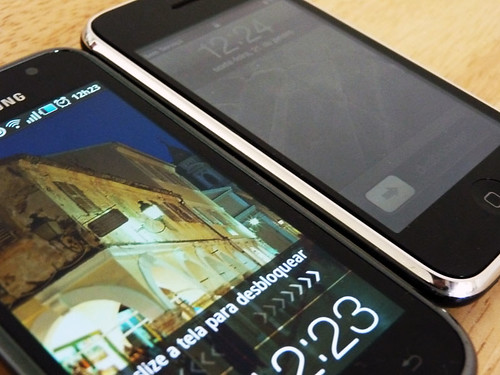This is a guest post! If you want to write for us, check out the Guest Post section.
Smartphones have become indispensable gadgets – not only do they serve as mobile phones; they practically help us manage our daily lives. It’s of course necessary to choose one with the right combination of features to suit your lifestyle. The top consideration for most people is whether to get an Android powered smartphone or an Apple iPhone.

[Photo via Flickr]
Before you buy your next smartphone, it would be good to settle the conundrum for yourself: Android vs iPhone – Which Smartphone is better? Here are some points of comparison, as well as a few useful smartphone buying tips to keep in mind.
1. Hardware
Since Android phones are produced by numerous companies, models vary in appearance, quality and features. This gives buyers a wider selection, but keep in mind that while there are many top-quality Android units, there are also several inferior ones.
The iPhone, being offered only by Apple, has more uniformity. Instead of diversity, they guarantee quality.
2. OS Support
Android smartphone manufacturers often take a long time to update their OS, and some don’t offer updates at all. Meanwhile, Apple consistently offers the latest features, while continuing support for older models.
3. Screen Size and Resolution
The biggest screens are offered on only Android. While some consider this an advantage, others see this as impractical since larger units are bulkier and use up more power.
The iPhone has always featured 3.5-inch screens. Despite the small size, they have higher resolutions. Recent iPhone models come with retina display.
4. Battery
Certain Android phones can go for a few days before recharging, while some need charging daily. In any model, a used up battery can be easily replaced.
Recent iPhone models take several days before having to recharge, and the battery life is generally longer than those of Android phones. But since iPhone batteries are built in, they can’t be replaced, except by a skilled technician.
5. Wireless Networking
Androids – particularly those equipped with 4G LTE technology – enable fast wireless access.
As of now, there are no true 4G iPhones; but we can expect the next iPhone to have 4G LTE capabilities.
6. App Selections
There is a wealth of applications available for Android, including free apps. Google-powered apps for Android include Google Translate, Google Maps, Google Sky Map, Google Earth and Google Goggle. On the downside, not all apps are compatible with all Android smartphones.
Since iPhones are produced by only one company, there is an assurance that the hardware works seamlessly with the software. The iPhone App store offers more apps, though not much variety; the most interesting apps also happen to be expensive.
7. Games
While there is an exceptional line up of Android games, the more popular games are available for the iPhone.
8. Social Networking
Social media apps for Android allow easier updating and viewing. Widgets also allow quick browsing.
Though the iPhone enables alerts and accommodates social media apps, it has gained a reputation for not being very suitable for social networking.
9. Interface and Customization
Android phones are thoroughly customizable; some features though, require a bit of technical skill. Users who need more memory can also upgrade the storage easily.
The iPhone has a sleek, user-friendly interface that is yet unequalled. It facilitates operation and provides an agreeable experience. However, the iPhone’s storage can’t be upgraded.
10. Photos, Music and Entertainment
Music streaming is a cinch on an Android; users can stream multiple tunes at the same time without needing an app – which can’t be done on an iPhone. With this, Android relies on third-party software for organizing photos, music and videos.
The iPhone has the simplicity and user-friendliness of the iPod. It enables easy file management and access, and excellent playback. iTunes also ensures compatibility and hassle-free syncing. Airplay allows for streaming photos, videos & music on Apple TV or Mac systems.
11. GPS Capability
Both Android and the iPhone accommodate GPS apps. But as of now, only Android has a free navigation app that provides excellent, step-by-step directions. Apple is working on step-by-step navigation system, which is seen in the recently released iOS 6 beta version.
12. Mobile Service Operators
Most telecommunications companies support Android phones as well as iPhones. Apple iPhone is even available on CDMA networks.
13. Price and Value for Money
Certain Android models are quite reasonably priced. If you have a rather tight budget, most telecom companies offer a free Android with certain subscription plans. However, consider that most free phones are likely older models or lower-quality ones.
iPhones may not be as affordable, but Apple takes pride in the fact that iPhones generally experience less problems.
Conclusion
It all depends on your preferences – perhaps a large screen and easy social networking is more useful to you, or maybe you need easier media organization and playback. Compare and contrast for yourself; which one is actually better? Then choose a smartphone that you think is more suited to your lifestyle.
Author Bio:
Peter Lee is a computer and technology geek that blogs at Computer How-to Guide. He is one gadget lover that couldn’t live without his laptop and smartphone. You can follow him on Twitter @com_howtoguide.
Warning: count(): Parameter must be an array or an object that implements Countable in /home/u265766359/domains/maheshkukreja.com/public_html/wp-content/themes/thesis_189/lib/classes/comments.php on line 43
{ 0 comments… add one now }